Abstract
Fluorescein isothiocyanate (FITC) has been used to study lymphocyte migration in sheep. After being labelled in vitro with FITC, lymphocytes migrated from blood into lymph at the same rate and with the same recovery as lymphocytes labelled with with the radioisotope 51chromium. The in vivo labelling of mesenteric lymph nodes (MLN) with FITC resulted in high numbers of labelled lymphocytes appearing in prescapular lymph. However, the appearance of the FITC-labelled lymphocytes in the prescapular lymph could be prevented by cannulating the main intestinal lymph duct prior to the in vivo labelling procedure. It was concluded that lymphocytes labelled in vivo within the MLN required an intact lymphatic system to reach the blood circulation and did not enter the venous circulation directly from the MLN.
Full text
PDF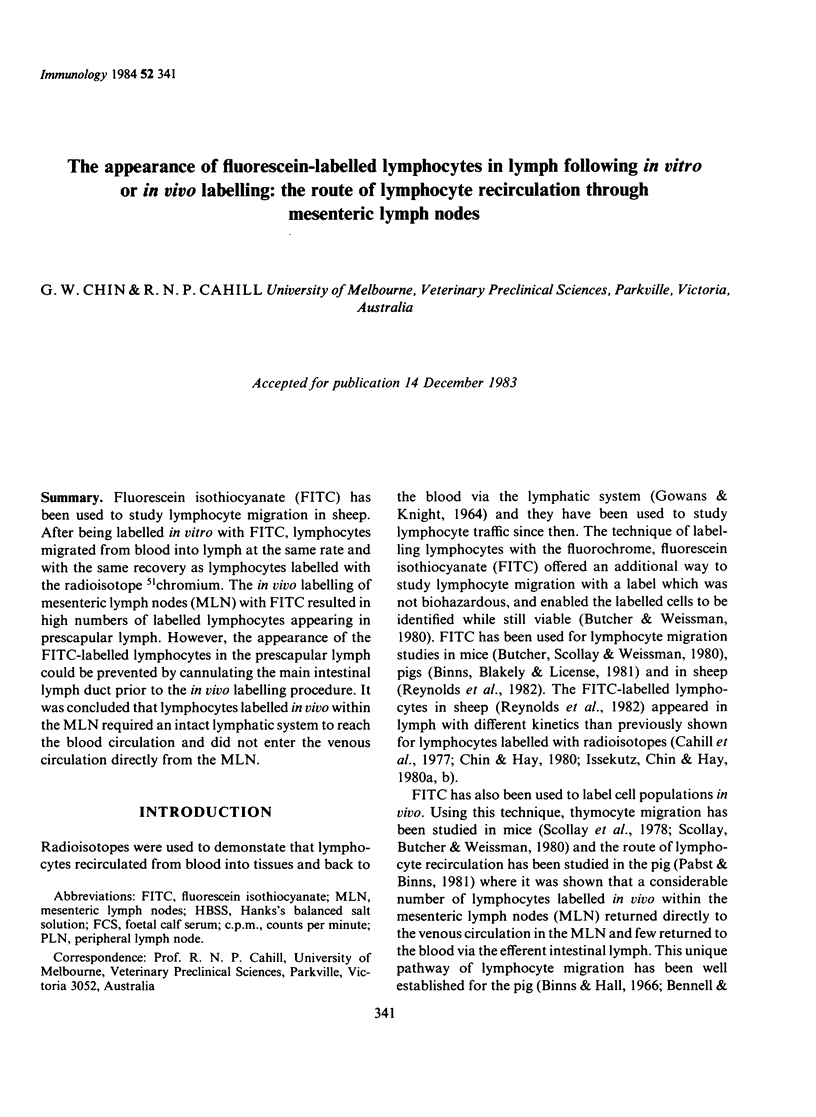
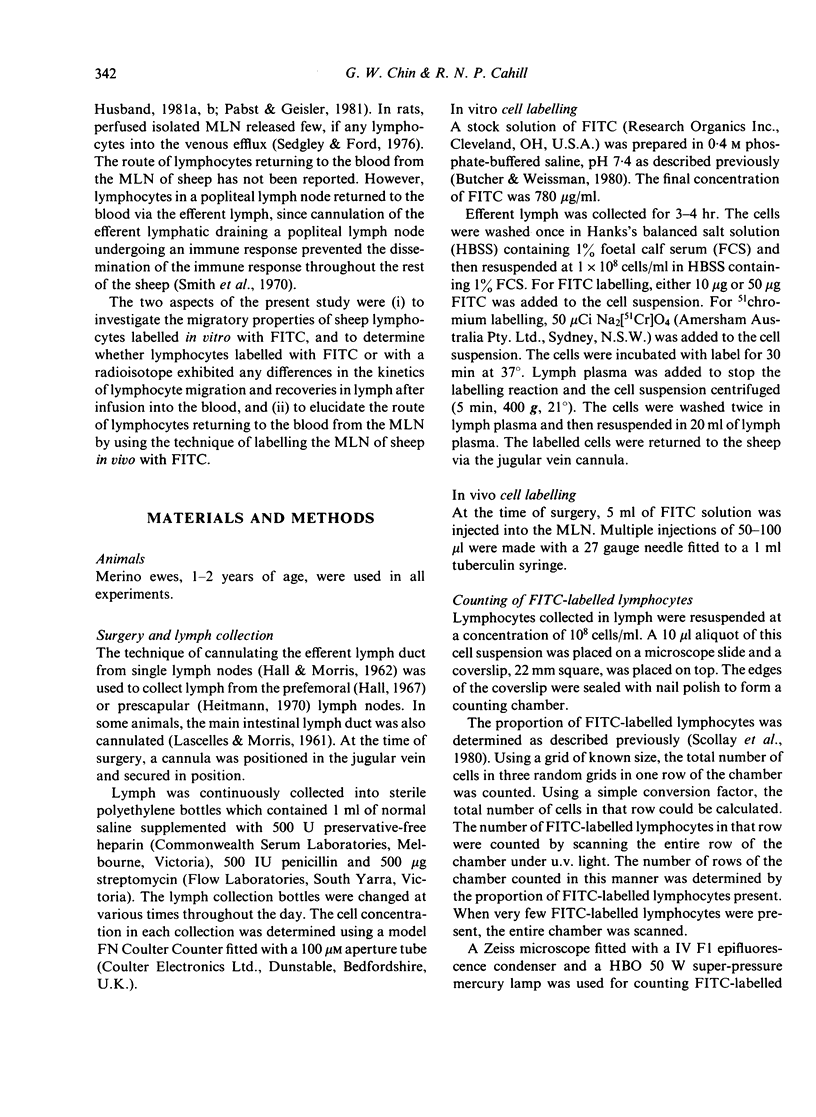
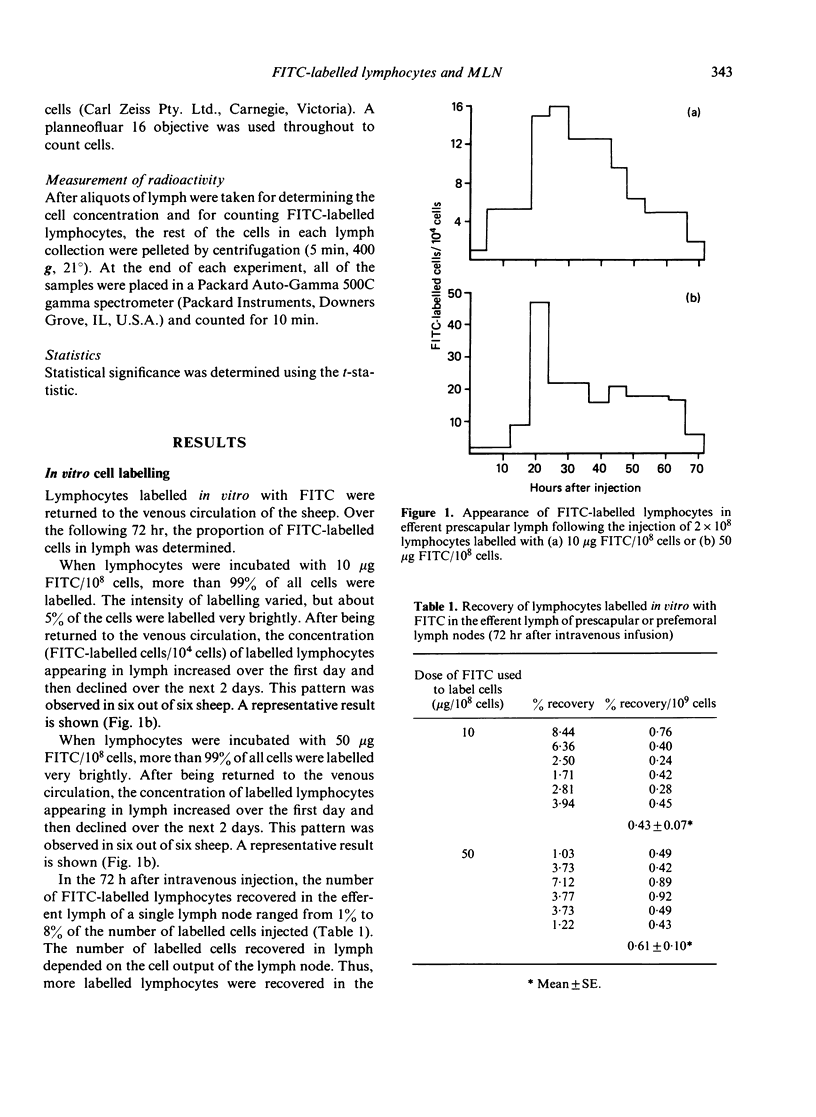
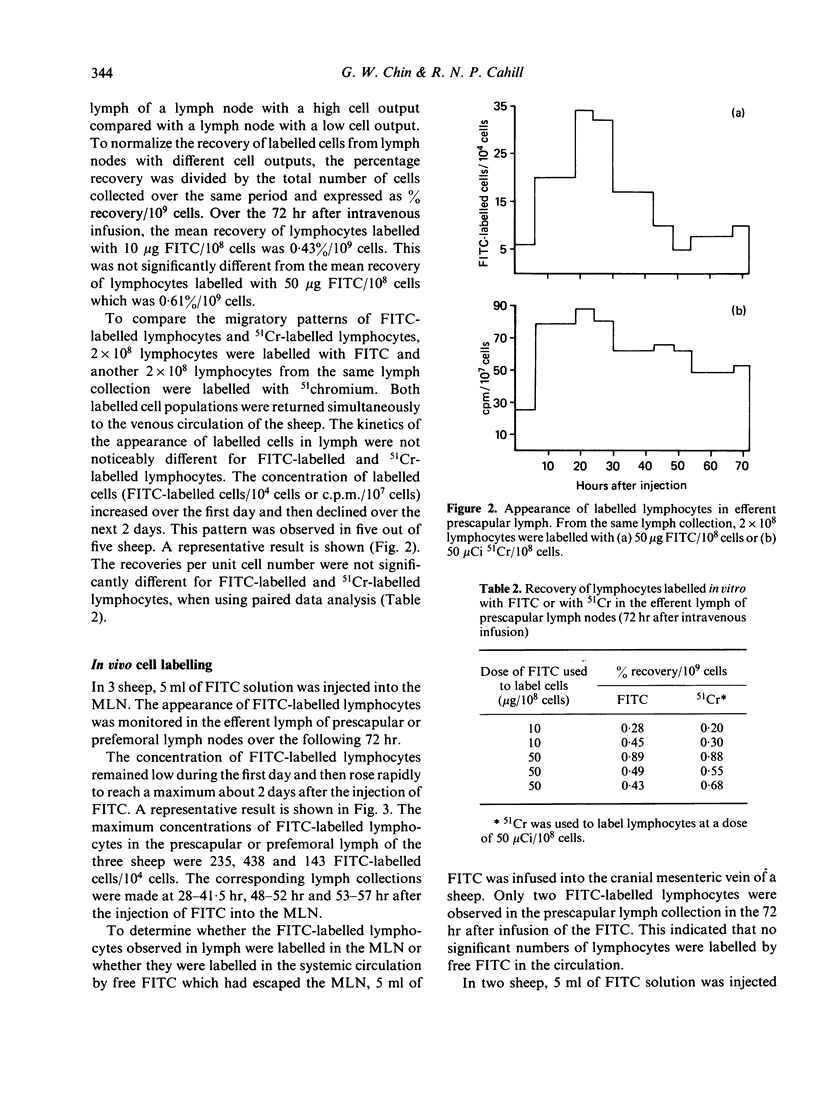
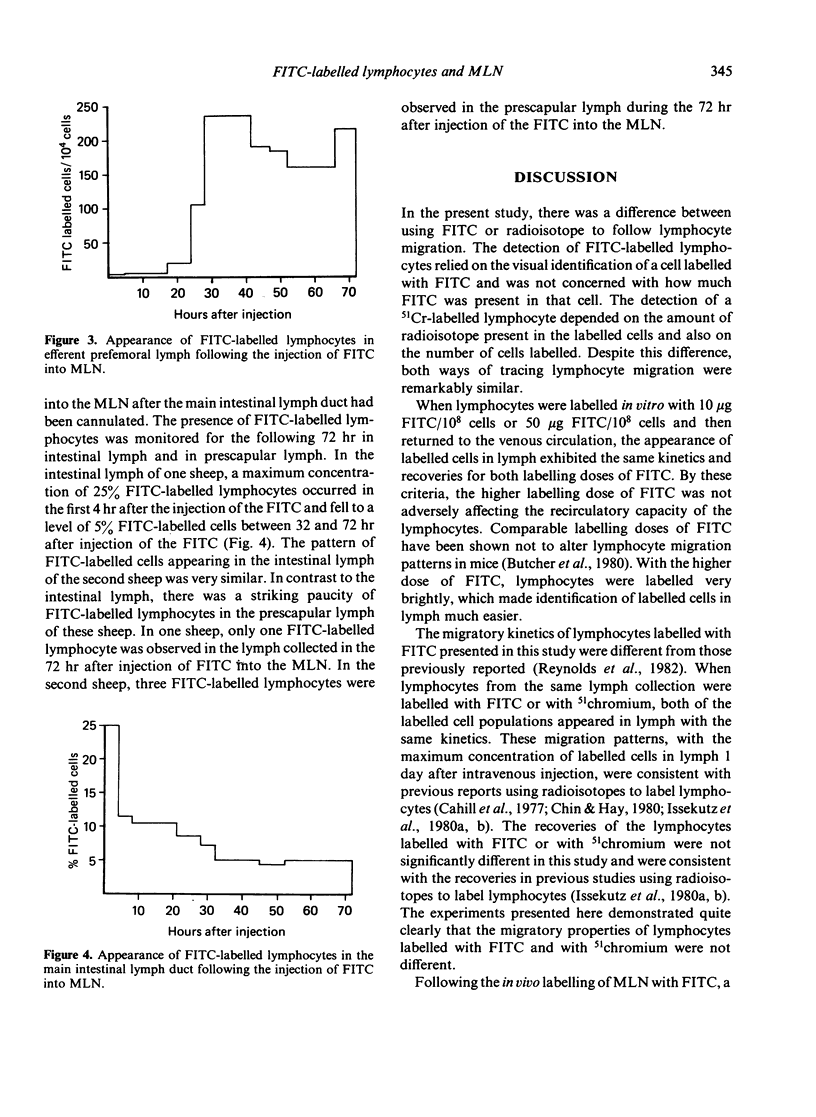
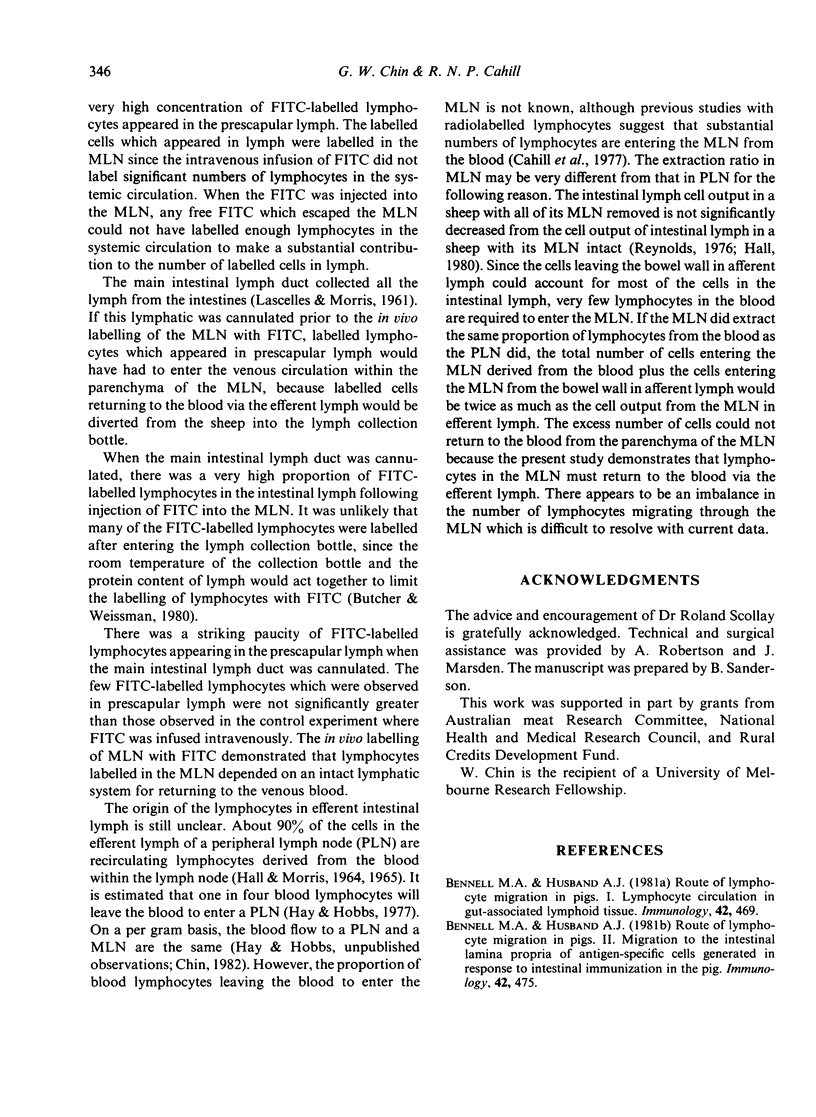
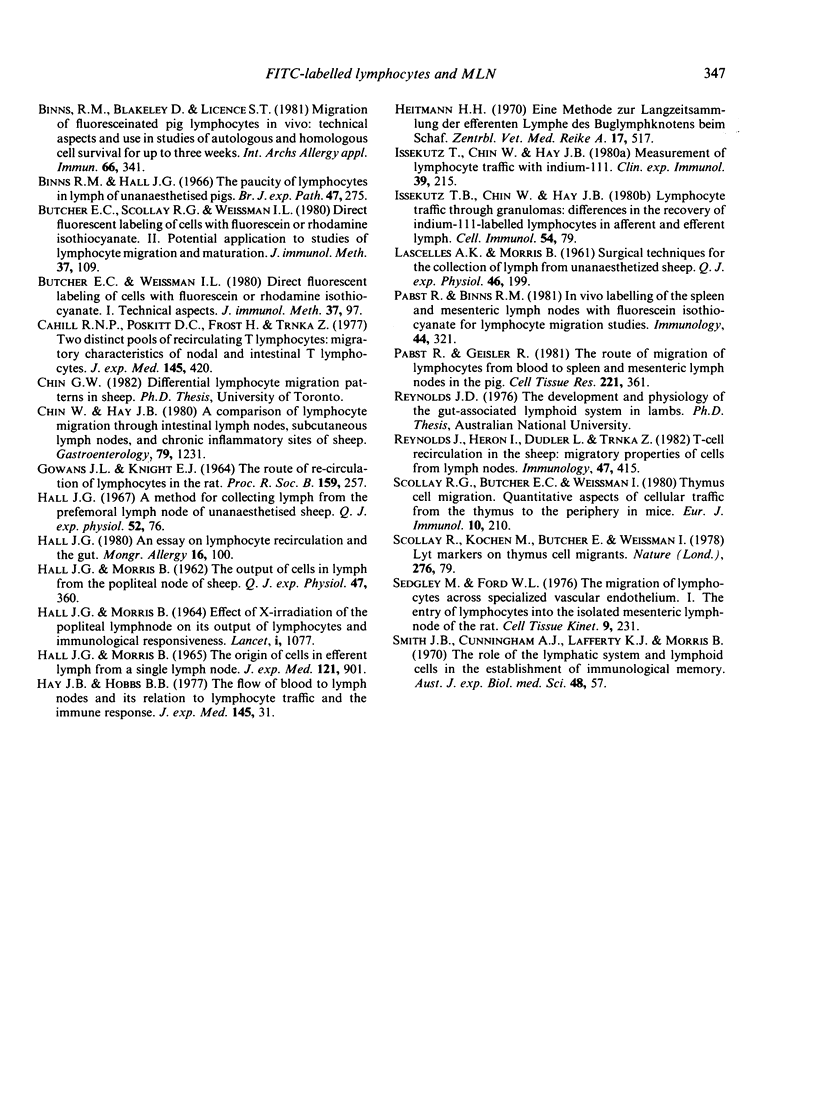
Selected References
These references are in PubMed. This may not be the complete list of references from this article.
- Bennell M. A., Husband A. J. Route of lymphocyte migration in pigs. I. Lymphocyte circulation in gut-associated lymphoid tissue. Immunology. 1981 Mar;42(3):469–474. [PMC free article] [PubMed] [Google Scholar]
- Bennell M. A., Husband A. J. Route of lymphocyte migration in pigs. II. Migration to the intestinal lamina propria of antigen-specific cells generated in response to intestinal immunization in the pig. Immunology. 1981 Mar;42(3):475–479. [PMC free article] [PubMed] [Google Scholar]
- Binns R. M., Blakeley D., Licence S. T. Migration of fluoresceinated pig lymphocytes in vivo: technical aspects and use in studies of autologous and homologous cell survival for up to three weeks. Int Arch Allergy Appl Immunol. 1981;66(3):341–349. doi: 10.1159/000232839. [DOI] [PubMed] [Google Scholar]
- Butcher E. C., Scollay R. G., Weissman I. L. Direct fluorescent labeling of cells with fluorescein or rhodamine isothiocyanate. II. Potential application to studies of lymphocyte migration and maturation. J Immunol Methods. 1980;37(2):109–121. doi: 10.1016/0022-1759(80)90196-9. [DOI] [PubMed] [Google Scholar]
- Butcher E. C., Weissman I. L. Direct fluorescent labeling of cells with fluorescein or rhodamine isothiocyanate. I. Technical aspects. J Immunol Methods. 1980;37(2):97–108. doi: 10.1016/0022-1759(80)90195-7. [DOI] [PubMed] [Google Scholar]
- Cahill R. N., Poskitt D. C., Frost D. C., Trnka Z. Two distinct pools of recirculating T lymphocytes: migratory characteristics of nodal and intestinal T lymphocytes. J Exp Med. 1977 Feb 1;145(2):420–428. doi: 10.1084/jem.145.2.420. [DOI] [PMC free article] [PubMed] [Google Scholar]
- Chin W., Hay J. B. A comparison of lymphocyte migration through intestinal lymph nodes, subcutaneous lymph nodes, and chronic inflammatory sites of sheep. Gastroenterology. 1980 Dec;79(6):1231–1242. [PubMed] [Google Scholar]
- GOWANS J. L., KNIGHT E. J. THE ROUTE OF RE-CIRCULATION OF LYMPHOCYTES IN THE RAT. Proc R Soc Lond B Biol Sci. 1964 Jan 14;159:257–282. doi: 10.1098/rspb.1964.0001. [DOI] [PubMed] [Google Scholar]
- HALL J. G., MORRIS B. EFFECT OF X-IRRADIATION OF THE POPLITEAL LYMPH-NODE ON ITS OUTPUT OF LYMPHOCYTES AND IMMUNOLOGICAL RESPONSIVENESS. Lancet. 1964 May 16;1(7342):1077–1080. doi: 10.1016/s0140-6736(64)91274-7. [DOI] [PubMed] [Google Scholar]
- HALL J. G., MORRIS B. THE ORIGIN OF THE CELLS IN THE EFFERENT LYMPH FROM A SINGLE LYMPH NODE. J Exp Med. 1965 Jun 1;121:901–910. doi: 10.1084/jem.121.6.901. [DOI] [PMC free article] [PubMed] [Google Scholar]
- HALL J. G., MORRIS B. The output of cells in lymph from the popliteal node of sheep. Q J Exp Physiol Cogn Med Sci. 1962 Oct;47:360–369. doi: 10.1113/expphysiol.1962.sp001620. [DOI] [PubMed] [Google Scholar]
- Hall J. G. An essay on lymphocyte circulation and the gut. Monogr Allergy. 1980;16:100–111. [PubMed] [Google Scholar]
- Hay J. B., Hobbs B. B. The flow of blood to lymph nodes and its relation to lymphocyte traffic and the immune response. J Exp Med. 1977 Jan 1;145(1):31–44. doi: 10.1084/jem.145.1.31. [DOI] [PMC free article] [PubMed] [Google Scholar]
- Issekutz T. B., Chin W., Hay J. B. Lymphocyte traffic through granulomas: differences in the recovery of indium-111-labeled lymphocytes in afferent and efferent lymph. Cell Immunol. 1980 Aug 15;54(1):79–86. doi: 10.1016/0008-8749(80)90191-4. [DOI] [PubMed] [Google Scholar]
- Issekutz T., Chin W., Hay J. B. Measurement of lymphocyte traffic with indium-111. Clin Exp Immunol. 1980 Jan;39(1):215–221. [PMC free article] [PubMed] [Google Scholar]
- LASCELLES A. K., MORRIS B. Surgical techniques for the collection of lymph from unanaesthetized sheep. Q J Exp Physiol Cogn Med Sci. 1961 Jul;46:199–205. doi: 10.1113/expphysiol.1961.sp001536. [DOI] [PubMed] [Google Scholar]
- Pabst R., Binns R. M. In vivo labelling of the spleen and mesenteric lymph nodes with fluorescein isothiocyanate for lymphocyte migration studies. Immunology. 1981 Oct;44(2):321–329. [PMC free article] [PubMed] [Google Scholar]
- Pabst R., Geisler R. The route of migration of lymphocytes from blood to spleen and mesenteric lymph nodes in the pig. Cell Tissue Res. 1981;221(2):361–370. doi: 10.1007/BF00216740. [DOI] [PubMed] [Google Scholar]
- Reynolds J., Heron I., Dudler L., Trnka Z. T-cell recirculation in the sheep: migratory properties of cells from lymph nodes. Immunology. 1982 Nov;47(3):415–421. [PMC free article] [PubMed] [Google Scholar]
- Scollay R. G., Butcher E. C., Weissman I. L. Thymus cell migration. Quantitative aspects of cellular traffic from the thymus to the periphery in mice. Eur J Immunol. 1980 Mar;10(3):210–218. doi: 10.1002/eji.1830100310. [DOI] [PubMed] [Google Scholar]
- Sedgley M., Ford W. L. The migration of lymphocytes across specialized vascular endothelium. I. The entry of lymphocytes into the isolated mesenteric lymph-node of the rat. Cell Tissue Kinet. 1976 May;9(3):231–243. doi: 10.1111/j.1365-2184.1976.tb01271.x. [DOI] [PubMed] [Google Scholar]
- Smith J. B., Cunningham A. J., Lafferty K. J., Morris B. The role of the lymphatic system and lymphoid cells in the establishment of immunological memory. Aust J Exp Biol Med Sci. 1970 Feb;48(1):57–70. doi: 10.1038/icb.1970.6. [DOI] [PubMed] [Google Scholar]


